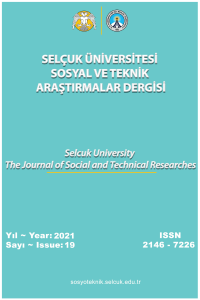Pandemi Döneminde Çalışan Anne Olmak: Metaforlar Üzerinden Bir Değerlendirme
Çalışan Kadın, Anne, Pandemi, Covid-19, Metafor, Nitel Analiz
___
- [1] Heggeness, M.L. "Why Is Mommy So Stressed? Estimating the Immediate Impact of the covid-19 Shock on Parental Attachment to the Labor Market and the Double-Bind of Mothers”, Instıtute Working Paper, vol. 33, 2020, https://doi.org/10.21034/iwp.33.
- [2] Walzer, S. (Ed. Ritzer, G.), Blackwell encylopedia of sociology. "Motherhood", Blackwell Reference: Blackwell Publishing, 2007, Erişim: http://www.blackwellreference.com/subscriber/tocnode
- [3] Arendell, T. "Conceiving and investigating motherhood: The decade’s scholarship", Journal of Marriage and the Family, vol. 62, no.4, ss. 1192-1207, 2000.
- [4] Glenn, E. N., Chang, G. and Forcey, L. R. (Eds.). "Mothering: Ideology, experience, and agency. " New York, NY: Routledge, 1994.
- [5] Ridgeway, C. and Correll, S., “Motherhood as a status characteristic", The Journal of Social issues, vol. 60, ss. 683-700, 2004.
- [6] Barlow, K. and Chapin, B.L., "The practice of mothering:an ıntroduction”, ETHOS, vol. 38, no.4, ss. 324–338, 2010.
- [7] Ulanowsky, C. E., "Women as mothers: Changing role perceptions an intergenerational study", PhD thesis, The Open University, 2009.
- [8] Kılıç, E., "Çalışma hayatında anneliğin dönüşümü: bursa ölçeğinde çalışan anneler üzerine bir uygulama araştırması”, Doktora Tezi, Uludağ Üniversitesi Sosyal Bilimler Enstitüsü, Bursa, 2020.
- [9] Schwartz, F.N., "Management women and the new facts of life”, Women in Management Review, vol. 4, no.5, ss.65-76, 1989.
- [10] Jayita P. ve Murali P., (Ed. A.R. Singh and S.A. Singh), “Working mothers: how much working, how much mothers, and where is the womanhood? in: some issues in womenís studies, and other essays" MSM, vol.7, no. Jan- Dec, ss. 63-79, 2009.
- [11] Lewis S. (Ed. Ann Phoenix – Anne Woollett- Eva Lloyd), Motherhood: Meanings, Practices and Ideologies (ss. 195-215) içinde “Motherhood and employment: the ımpact of social and organizational values”, London: Sage Publications Inc., 1991.
- [12] Akyol, A. "Anneliğin kadın çalışanlar üzerine etkileri: yorumsamacı bir alan araştırması", Doktora Tezi, Hacettepe Üniversitesi Sosyal Bilimler Enstitüsü, Ankara, 2018.
- [13] Brower,B., "Working moms are struggling: here’s how to actually celebrate mothers ", Forbes, 9 May 2021, Erişim: https://www.forbes.com/sites/tracybrower/2021/05/09/working-moms-are-struggling-heres-how-to-actually-celebrate-mothers/?sh=1983a24d6e74
- [14] Kansal, K. "Qualitative analysis of covid-19 on working women", International Journal of Scientific and Research Publications, vol. 10, no.6, 41-44, 2020.
- [15] Hays, S. (Ed. Skolnick ve J. Skolnick), Family in Transition (6. baskı. ss.41-60). "The mommy wars: ambivalence, ideological work and the cultural contradictions of motherhood”, Boston: Pearson, 2011.
- [16] Denzin, N.K. and Lincoln, Y.S., “The Sage handbook of qualitative research", 3rd ed., Thousand Oaks, CA:Sage, 2005.
- [17] Merriam, S.B., "Nitel araştırma desen ve uygulama için bir rehber". 3.Basımdan Çeviri (Çeviri Editör: Selahattin Turan). Nobel, Ankara, 2018.
- [18] Redden, S. M. (Ed. Matthes, C. S. Davis and R. F. Potter), The International Encyclopaedia of Communication Research Methods, “Metaphor Analysis”, Wiley-Blackwell, 2017. [19] Güneş, A. ve Fırat, M., "Açık ve uzaktan öğrenmede metafor analizi araştırmaları", Açıköğretim Uygulamaları ve Araştırmaları Dergisi, vol. 2, no. 3, ss. 115-129. 2016.
- [20] Pitcher, R., "Using metaphor analysis: MIP and beyond”, The Qualitative Report, vol. 18, no. 68, ss. 1-8, 2013. [21] Ignatow, G. and Mihalcea, R. "Metaphor analysis" In Text mining (pp. 96-104). SAGE Publications, Inc, 2017.
- [22] Moser, K. S., "Metaphor analysis in psychology – method, theory, and fields of application", Qualitative Social Research, vol. 1, no. 2, 2000.
- [23] Schmitt, R., "Systematic metaphor analysis as a method of qualitative research”, The Qualitative Report, vol. 10, no. 2, 358–394, 2005.
- [24] Miles, M. B. and Huberman, A. M., "An expanded sourcebook qualitative data analysis”, Thousand Oaks, California: Sage Publications, 1994.
- [25] Kelime Bulutu, Erişim Adresi: https://voyant-tools.org/
- [26] Deloitte, "Understanding the pandemic’s impact on working women", 2020. Erişim adresi: https://www2.deloitte.com/content/dam/Deloitte/global/Documents/About-Deloitte/gx-about-deloitte-understanding-the-pandemic-s-impact-on-working-women.pdf.
- Başlangıç: 2011
- Yayıncı: Selçuk Üniversitesi
Pazarlamada ‘Marka Aşkı’ Kavramının Bibliyometrik Analizi: Çalışmalar ve Eğilimler
Pandemi Döneminde Çalışan Anne Olmak: Metaforlar Üzerinden Bir Değerlendirme
Amina HOUIMI, Serap YİĞİT GEZGİN, Yasemin GÜNDOĞDU, Hamdi Şükür KILIÇ
Geçmişten Günümüze Portföy Yönetiminde Neler Değişti? R Programı ile Bibliyometrik Analiz
İnsan Hakları Hukuku Açısından Kadına Şiddet
Abdülazim İBRAHİM, Asiye Nurşen DAĞ
Modern Yönetimin Adı: Toplam Kalite Yönetimi
Kurumsal Sosyal Sorumluluk Faaliyetlerinin Marka Sadakatine Etkisi
